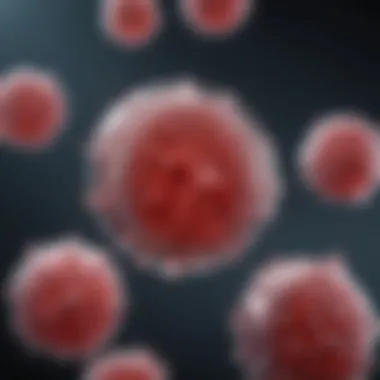Exploring the HT22 Cell Line: Research Implications


Intro
The HT22 cell line has become significant in various fields of scientific research, particularly in understanding neurological processes and disorders. As a hippocampal cell line, it provides researchers with a versatile tool for studying neuronal function and the mechanisms underlying neurodegenerative diseases. The origin and unique characteristics of HT22 cells offer insight into their reliability and efficacy in experimental setups.
Research Overview
Summary of Key Findings
HT22 cells have been the subject of extensive studies that have highlighted their responsiveness to oxidative stress, making them particularly useful in studies related to neuroprotection and neurotoxicity. Research has demonstrated that these cells retain neuronal properties, providing a rich environment to study synaptic function and neuroinflammation. Studies utilizing the HT22 cell line have also led to the discovery of potential therapeutic targets for diseases such as Alzheimer’s and Parkinson’s.
Importance of the Research in Its Respective Field
The findings derived from HT22 cell line research have far-reaching implications. They enhance our understanding of how neurons respond to different stimuli and stressors. This knowledge is crucial as it informs the development of neuroprotective strategies and therapeutic interventions in the treatment of age-related neurodegenerative diseases. Thus, HT22 cells serve as a pivotal platform for neuroscientific research, bridging laboratory findings to clinical applications.
Methodology
Description of the Experimental or Analytical Methods Used
Research involving HT22 cells typically employs various experimental approaches to investigate cellular behavior and response mechanisms. Common methods include:
- Western Blotting: Used to analyze protein expression levels and post-translational modifications.
- Cell Viability Assays: Such as the MTT assay, to assess the impact of different treatments on cell health.
- Flow Cytometry: For analyzing cell cycle progression and apoptosis.
- Immunofluorescence: To visualize specific proteins within cells, aiding in understanding cellular architecture and function.
Sampling Criteria and Data Collection Techniques
When conducting experiments, cells are usually cultured in Dulbecco's Modified Eagle Medium (DMEM) supplemented with fetal bovine serum and necessary antibiotics. Researchers maintain strict criteria for sampling, ensuring that cells selected for experiments have completed a sufficient number of passages to eliminate variability. Data collection often involves automated imaging systems, as well as manual counting procedures to maintain accuracy. The analysis of results usually incorporates statistical software to validate findings.
"The HT22 cell line stands as a hallmark in the exploration of neurobiological phenomena, revealing insights that may transform therapeutic approaches in neuroscience."
Understanding the methodologies employed in HT22 cell research offers context to the findings, underpinning their relevance in the scientific community.
This groundwork sets the stage for further discussions on the practical applications of HT22 cells in various experimental contexts and their role in advancing our knowledge of neuronal health and disease.
Foreword to HT22 Cells
The HT22 cell line serves as a pivotal tool in neurobiological research, providing insights into neuronal function and various neurodegenerative diseases. Understanding this cell line is essential for both foundational and applied research. Its relevance lies not merely in its laboratory applications, but in the broader implications for human health. Many researchers lean towards HT22 cells due to their unique characteristics that allow for comprehensive studies related to the central nervous system.
Definition and Origin
HT22 cells are derived from the hippocampus of a mouse, specifically from C57BL/6 strain. This immortalized cell line is a variation of neuronal-like cells that exhibit qualities representative of the neurons found in human biology. They are especially regarded for their ability to grow and multiply in vitro, making them a practical choice for various experimental settings. The origin of HT22 cells underscores their importance since the hippocampus plays a crucial role in learning and memory functions.
Development and Characterization
The development of HT22 cells involved specific methods to ensure their biological relevance. After their establishment, researchers characterized these cells to understand their properties better. Key characteristics include their resistance to oxidative stress and the ability to secrete neuroprotective substances. Characterization studies revealed that HT22 cells retain many functional aspects of neurons, such as neurotransmitter production and synaptic-like activity.
In essence, the exceptional features of HT22 cells underscore the significance of this model in studying not only cellular behavior but also intricate mechanisms involved in various neurological disorders. Their robustness and relevance make them favorable for investigative research into potential therapeutic avenues.
Biological Characteristics of HT22 Cells
Understanding the biological characteristics of HT22 cells is essential for comprehending their applicability in various research contexts. HT22 cells are a well-established neuronal cell line developed from the hippocampus of mice. Their unique features enable researchers to explore the complexities of neuronal function and neurodegeneration. The assessment of these biological traits can reveal insights about cellular behaviors and responses under various experimental conditions.
Morphological Features


HT22 cells exhibit distinctive morphological characteristics that set them apart from other cell lines. Typically, these cells are adherent and spread out flat on the culture surface. They form a monolayer which allows for easier observation and manipulation. Their shape is often polygonal, and they may develop extended processes resembling neuronal-like structures under specific conditions. This morphological plasticity underlines their suitability for studies regarding growth factors and neurotrophic influences on neuronal cells.
Genetic Profile
Examining the genetic profile of HT22 cells is pivotal in identifying their relevance to neuronal studies. These cells maintain expression of various neuronal markers such as MAP2 and NeuN, making them operational models for neuronal research. The genetic stability of HT22 cells allows them to be used repeatedly across different experimental setups without significant genetic drift. Understanding this genetic stability is critical when drawing conclusions from experiments. Moreover, the cell line's susceptibility to stimuli such as oxidative stress provides an avenue for investigating genetic responses to neurotoxins.
Functional Properties
The functional properties of HT22 cells are significant for their applications in neuroscience and pharmacological research. These cells retain several important functions typical of neurons, including neurotransmitter release and response to synaptic activity. HT22 cells have demonstrated the ability to release glutamate, a critical neurotransmitter, thus serving as a model for studying excitotoxicity. Furthermore, they can respond to various neuroprotective agents, which is vital for evaluating potential therapies for neurons affected by degenerative diseases.
"HT22 cells serve as a valuable model system for investigating neuronal survival and stress response mechanisms."
This unique combination of morphological traits, genetic stability, and functional capabilities positions HT22 cells as an instrumental tool in elucidating pathways related to neuronal health and disease.
Applications in Neuroscience Research
The HT22 cell line plays a crucial role in understanding various aspects of neuroscience. It serves not just as a model for studying neuronal properties, but also offers a platform for dissecting the complexities of neurodegenerative disorders. In research, the use of HT22 cells provides several benefits, such as a consistent cellular environment and the ability to mimic conditions relevant to human health. Understanding the applications of HT22 cells in neuroscience is essential for the advancement of therapeutic developments and improving our knowledge of brain function and disease.
Modeling Neuronal Behavior
HT22 cells are useful for modeling neuronal behavior due to their ability to exhibit characteristics akin to hippocampal neurons. These cells are often employed to study synaptic transmission, neuroplasticity, and mechanisms of learning and memory. One significant feature of HT22 cells is their ability to undergo differentiation under the right conditions. This differentiation allows them to mimic the functional aspects of neurons. Researchers leverage this attribute to explore signaling pathways, electrophysiological properties, and the effects of neurotrophic factors.
Moreover, the HT22 cell line can be exposed to various stimuli to simulate neurological conditions. For instance, applying oxidative stress agents can trigger responses that mirror pathological states in neurons. This capability makes it a valuable tool for studying neurotransmitter release and uptake, which are fundamental in understanding neuronal communication. By modeling these behaviors in HT22 cells, researchers gain insights into the complexities of neuronal dynamics and the biological underpinnings of cognitive functions.
Investigating Neurodegenerative Disorders
The implications of using HT22 cells extend significantly into the realm of neurodegenerative disorders. Conditions such as Alzheimer's disease, Parkinson's disease, and amyotrophic lateral sclerosis have complex etiologies. The HT22 cell line offers a platform for investigating cellular responses to neurotoxic agents and genetic manipulations that mimic these diseases. Researchers can analyze how neurotoxic substances impact cell viability, apoptosis, and the overall health of HT22 cells, providing insights applicable to human disorders.
Specifically, HT22 cells are often utilized to study the role of oxidative stress and inflammatory responses in neurodegeneration. By understanding these mechanisms, researchers can identify potential therapeutic targets. An example includes examining the effects of amyloid-beta peptides, which are crucial in Alzheimer's pathology. Through the exploration of amyloid interactions with HT22 cells, scientists glean essential information about the early events in neurodegenerative processes, leading to the development of targeted interventions.
Drug Discovery and Testing
Drug discovery is another critical application of the HT22 cell line in neuroscience research. With the rise of drug-resistant neurodegenerative conditions, effective testing protocols are necessary to evaluate the potential benefits of new compounds. HT22 cells allow researchers to screen various drugs for neuroprotective effects efficiently. Understanding how different compounds influence HT22 cell survival and function provides a basis for assessing their applicability in clinical settings.
In the context of pharmacology, HT22 cells can also facilitate the screening of anti-inflammatory and neuroprotective agents. By employing assays to measure cell viability, apoptosis, and mitochondrial function, researchers can determine the efficacy of candidate drugs.
"The HT22 cell line acts as a physiological model to evaluate the potential therapeutic impact of novel compounds in neuroscience."
Furthermore, the HT22 model is often used in combinatorial studies where the effects of drug combinations are evaluated. This approach can enhance therapeutic strategies, particularly in cases where single agents prove ineffective. In essence, using HT22 cells in drug discovery enhances our understanding of therapeutic windows and drug interactions relevant to neurodegenerative diseases.
Methodological Framework in HT22 Research
The methodological framework used in HT22 research plays a crucial role in generating reproducible and significant findings in studies focused on neuroscience and neurodegeneration. Understanding the intricate details of cell culture techniques, assessment of cell viability, and molecular analysis methods are essential for maximizing the potential of HT22 cells as a model system. A clear methodological approach allows researchers to explore neuronal behavior and cellular responses under various experimental conditions, contributing to important discoveries in the understanding of neurobiology.
Cell Culture Techniques
Cell culture forms the foundation of any research involving the HT22 cell line. The success of experiments heavily relies on employing the right culture methods to maintain the health and viability of the cells. HT22 cells are typically cultured in a specific medium, often DMEM (Dulbecco's Modified Eagle Medium) supplemented with fetal bovine serum (FBS) and antibiotics to inhibit bacterial growth. It is critical to manage the temperature, humidity, and CO2 levels within incubators to provide an optimal environment for cell growth.
Key considerations include:
- Passaging: Regular passaging is necessary to prevent over-confluency, which can lead to changes in cell behavior.
- Contamination: Aseptic techniques should be practiced diligently to avoid contamination of cultures, as this can invalidate experimental results.
- Substrate: HT22 cells require a suitable surface for adhesion, which impacts their growth and functional properties.
Assessment of Cell Viability


Assessing cell viability is a fundamental aspect of HT22 research. Understanding how experimental conditions affect cell health can inform experimental design and interpretations of findings. Various assays can be employed to evaluate cell viability, including the MTT assay, which measures metabolic activity, and the Trypan blue exclusion test, which differentiates viable cells from non-viable ones.
When conducting these assessments, researchers should consider:
- Time Points: Choosing appropriate time points for viability assessment can highlight the dynamics of cellular responses over time.
- Control Conditions: Establishing control groups is essential to compare how treatment conditions impact cell viability.
The precise evaluation of cell viability allows researchers to distinguish between cytotoxic and non-cytotoxic effects of different treatments on HT22 cells.
Molecular Analysis Methods
Molecular analysis methods provide insights into the biochemical and genetic alterations in HT22 cells under experimental conditions. Techniques such as quantitative PCR, Western blotting, and flow cytometry are commonly employed to analyze gene expression, protein levels, and cell signaling pathways. These methodologies help in elucidating the mechanisms underlying various neuronal functions and neurodegenerative processes.
Import considerations include:
- Sample Preparation: Proper preparation and handling of samples are crucial to obtain reliable data.
- Reproducibility: Employing standardized protocols ensures that results are reproducible across different experiments.
In summary, establishing a rigorous methodological framework in HT22 research is fundamental for uncovering the complexities of neuronal function and developing strategies for therapeutic interventions. By focusing on effective cell culture techniques, robust viability assessments, and thorough molecular analyses, researchers can enhance the quality and relevance of their findings.
Implications of Findings from HT22 Studies
The HT22 cell line serves as a critical model in neuroscience research. The significance of findings derived from studies utilizing HT22 cells extends far beyond initial observations. Understanding how these cells behave and respond to various stimuli allows researchers to gain insights into fundamental aspects of neuronal function.
One of the main implications is the enhancement of our knowledge regarding neurobiology, particularly in the context of neuroprotection. As researchers explore the responses of HT22 cells to stressors, including oxidative stress and neurotoxic agents, the implications become evident. It leads to a deeper understanding of how neurons might survive or fail in adverse conditions. This knowledge can inform strategies for combatting neurodegenerative diseases, a growing concern in aging populations.
Additionally, HT22 studies contribute significantly to therapeutic strategies aimed at mitigating cellular damage. By identifying key molecular pathways involved in neuronal survival, researchers can potentially develop targeted interventions. This can influence future treatment modalities that focus not only on symptomatic relief but on underlying mechanisms of neuroprotection.
Insights into Neuronal Function
HT22 cell line studies offer vital insights into how neurons function under various conditions. Researchers can manipulate these cells to simulate physiological and pathological states. This modeling allows for the analysis of critical processes like synaptic transmission and cell signaling.
By investigating signaling pathways activated in HT22 cells, researchers uncover fundamental aspects of neuronal activity that are often hidden in more complex systems. For instance, understanding how HT22 cells respond to excitotoxicity helps delineate the mechanisms by which neurons maintain homeostasis.
Understanding these responses can lead to the development of treatments that support neuronal health in disorders such as Alzheimer's and Parkinson's diseases.
Understanding Neuroprotection Mechanisms
HT22 cells display unique neuroprotective mechanisms when exposed to neurotoxic agents. Research indicates that certain compounds can enhance the resilience of HT22 cells. Investigating these characteristics reveals how endogenous neuroprotective pathways can be harnessed.
Studies show that regulating glutamate-induced cytotoxicity in HT22 cells furthers our grasp on neuroprotective strategies. Specifically, the identification of anti-apoptotic factors activated by therapeutic agents nurtures the exploration of new drugs aimed at preserving neuronal integrity.
This understanding of neuroprotection may unveil therapeutic targets that can halt or reverse neurodegeneration, thereby offering hope to individuals suffering from debilitating brain diseases.
Contribution to Therapeutic Strategies
The insights gained from HT22 cell line research have profound implications for developing therapeutic strategies. By understanding the cellular and molecular interactions that promote or inhibit neuronal survival, researchers can propose mechanisms that might be manipulated for clinical benefit.
For example, neurotransmitter systems examined in HT22 studies can indicate optimal approaches to pharmacological intervention. Furthermore, effects of various compounds on HT22 cells can aid in determining the potential for new drugs to mitigate neuronal apoptosis or promote regeneration.
Moreover, findings from HT22 research inform preclinical trials designed to test the efficacy of novel compounds. This foundational work is crucial for ensuring that future therapies are both effective and safe for human use.
The HT22 cell line not only enriches our current understanding of neuronal biology, but also paves the way for innovative therapeutic approaches that have the potential to change the clinical landscape of neurodegenerative diseases.
Limitations and Challenges of HT22 Cell Line


The exploration of the HT22 cell line comes with its own set of limitations and challenges that researchers must navigate. Understanding these factors is vital for evaluating the reliability and applicability of HT22 in various research contexts. Several issues may arise when utilizing this cell line, impacting the interpretation of results and the translation of findings to in vivo settings. Researchers often face hurdles related to species specificity and biological variability, which can significantly influence the outcomes of experiments involving HT22 cells.
Species Specificity
One of the principal limitations of the HT22 cell line is its species specificity. Originating from murine (mouse) hippocampal cells, HT22 is designed to replicate certain neuronal characteristics. However, its mouse lineage may hinder the translational potential of findings to human physiology. Results obtained from HT22 may not accurately reflect human neuronal behavior or responses, especially in the context of neurodegenerative diseases. Different species can exhibit diverse biological pathways and responses, making it critical to approach experiments with caution.
- Studies must consider whether the findings from HT22 can be generalized to human systems.
- It is essential for researchers to validate their results using human-derived neuronal cells in conjunction with HT22 experiments.
In light of these factors, a comprehensive understanding of species differences enhances the overall scientific rigor of HT22 research. Understanding the distinction between murine and human biological responses improves experimental design and endpoint interpretations in neuroscience studies.
Biological Variability
Biological variability also serves as a significant challenge when working with HT22 cells. Cell lines are not static entities; they can undergo genetic drift or phenotypic changes over time. This variability can stem from several factors, including culture conditions, passage number, and environmental influences. Such changes may affect gene expression, cell behavior, and overall responsiveness to treatments.
To mitigate these issues, researchers should:
- Regularly monitor and characterize HT22 cells to ensure consistency.
- Employ standardized culture techniques to minimize variations between experiments.
- Include controls to account for potential discrepancies during experimental analysis.
Biological variability underscores the importance of replicating experiments within a given timeframe and using well-characterized batches of HT22 cells. Such practices amplify the validity of observed effects and reduce noise in the data.
Future Directions in HT22 Research
The realm of neural cell research is constantly evolving. The HT22 cell line stands at a pivotal juncture in this journey. As we delve into the future directions of HT22 research, it is significant to understand its potential for advancing our knowledge in neuroscience. HT22 cells offer unique insights into neuronal behavior, making them invaluable for ongoing studies.
Emerging Technologies in Cell Research
Technological advancements are changing the landscape of cellular research. Key developments such as CRISPR-Cas9 gene editing, high-throughput screening, and systems biology are becoming integral to HT22 research.
- CRISPR-Cas9: This powerful tool enables precise editing of genes. Researchers can target specific neuronal pathways, allowing modification of the cellular genome of HT22 cells. This leads to better models for studying neurodegenerative diseases.
- High-throughput screening: This technology allows the testing of numerous compounds in a short time. It can be applied to HT22 cells to investigate potential neuroprotective agents or new drugs.
- Systems biology: This integrative approach combines biological data with computational models. It allows researchers to understand complex interactions in HT22 cells, contributing to a holistic view of cellular functions in neuronal contexts.
These emerging technologies can enhance the capabilities of HT22 research, paving the way for more comprehensive studies and potential therapeutic discoveries.
Integrative Approaches in Neuroscience
Future HT22 research must embrace interdisciplinarity. Integrative approaches yield a richer understanding of neuroscience. By combining different fields such as molecular biology, pharmacology, and bioinformatics, researchers can enhance the application of HT22 cells in various studies.
- Collaboration between disciplines: Neuroscientists, biochemists, and data scientists can work together to attract a broader range of perspectives. This collaboration may lead to innovative hypotheses and experimental designs.
- Translational research: Bridging basic science with clinical applications is more crucial than ever. HT22 cell studies can inform potential clinical strategies for treating neurodegenerative disorders, offering a path towards real-world applications.
- Public engagement: Engaging with the broader community can help in understanding specific research needs and societal implications. The inclusion of perspectives from various stakeholders can guide future research directions.
Integrative approaches show promise in fostering deeper insights into neurological conditions, ultimately enhancing our understanding of how HT22 cells can contribute to advancements in neuroscience.
The future of HT22 research lies in leveraging technology and interdisciplinary collaboration to unlock the full potential of these unique neural cells.
By focusing on these future directions, researchers can cultivate a myriad of new possibilities, thereby enriching the field of neuroscience and contributing to a deeper understanding of neuronal health and disease.
Epilogue
The conclusion of this article encapsulates the significance of the HT22 cell line in scientific research. Understanding the multifaceted characteristics and applications of HT22 cells has profound implications for advancing knowledge in neuroscience and related fields. The HT22 cell line serves as a vital model for studying neuronal behavior and investigating neurodegenerative disorders, which are increasingly relevant topics in contemporary research.
Summary of Key Points
Key points discussed throughout this article highlight the unique characteristics of HT22 cells. These cells not only provide insights into cellular mechanisms but also serve as effective tools in drug discovery and neuroprotection studies. The following points summarize the critical aspects:
- Origin and Development: HT22 cells originated from mouse hippocampal cells and were characterized for their ability to proliferate and differentiate, making them a perfect model for studying neuronal functions.
- Biological Characteristics: HT22 cells display distinct morphological and functional properties. Their genetic profile allows researchers to assess various signaling pathways involved in neurodegenerative processes.
- Applications in Research: The applications of HT22 cells extend to modeling diseases such as Alzheimer's and studying the effects of neuroprotective compounds. This makes them instrumental in drug testing.
- Methodological Framework: Research methodologies involving HT22 cells, such as cell viability assays and molecular analysis, provide robust frameworks for studying cellular responses in a controlled environment.
- Implications of Findings: Research stemming from HT22 studies contributes to our understanding of neuronal function, mechanisms of neuroprotection, and the development of therapeutic strategies.
The Significance of HT22 in Scientific Research
The HT22 cell line epitomizes the intersection of cellular biology and neurological science. Its significance lies in its role as a model for both basic and applied research. The ability of HT22 cells to mimic certain neuronal traits offers unique advantages:
- Contribution to Knowledge: Research using HT22 contributes to the larger scientific dialogue concerning neuronal health and disease. This is increasingly important as the global population ages, bringing neurodegenerative diseases to the forefront of medical research.
- Therapeutic Developments: Insights gained from HT22 studies can inform therapeutic strategies aimed at treating a range of disorders, thus enhancing their potential impact on public health.
- Foundation for Future Studies: As researchers continue to explore new horizons in cell and molecular biology utilizing HT22 cells, this line of investigation is likely to produce novel findings that could reshape our understanding of brain function and disease mechanisms.







